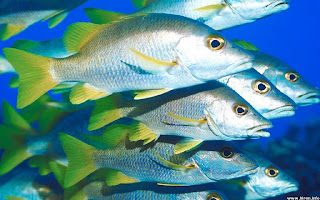Ocean overfishing is simply the taking of wildlife from the sea at rates
too high for fished species to replace themselves. The earliest
overfishing occurred in the early 1800s when humans, seeking blubber for
lamp oil, decimated the whale population. Some fish that we eat,
including Atlantic cod and herring and California's sardines, were also
harvested to the brink of extinction by the mid-1900s.
Highly disruptive to the food chain, these isolated, regional depletions became global and catastrophic by the late 20th century.
When It Started
Marine scientists know when widespread overfishing of the seas began. And they have a pretty good idea when, if left unaddressed, it will end.
In the mid-20th century, international efforts to increase the availability and affordability of protein-rich foods led to concerted government efforts to increase fishing capacity. Favorable policies, loans, and subsidies spawned a rapid rise of big industrial fishing operations, which quickly supplanted local boatmen as the world's source of seafood.
These large, profit-seeking commercial fleets were extremely aggressive, scouring the world's oceans and developing ever more sophisticated methods and technologies for finding, extracting, and processing their target species. Consumers soon grew accustomed to having access to a wide selection of fish species at affordable prices.
But by 1989, when about 90 million tons (metric tons) of catch were taken from the ocean, the industry had hit its high-water mark, and yields have declined or stagnated ever since. Fisheries for the most sought-after species, like orange roughy, Chilean sea bass, and bluefin tuna have collapsed. In 2003, a scientific report estimated that industrial fishing had reduced the number of large ocean fish to just 10 percent of their pre-industrial population.
Highly disruptive to the food chain, these isolated, regional depletions became global and catastrophic by the late 20th century.
When It Started
Marine scientists know when widespread overfishing of the seas began. And they have a pretty good idea when, if left unaddressed, it will end.
In the mid-20th century, international efforts to increase the availability and affordability of protein-rich foods led to concerted government efforts to increase fishing capacity. Favorable policies, loans, and subsidies spawned a rapid rise of big industrial fishing operations, which quickly supplanted local boatmen as the world's source of seafood.
These large, profit-seeking commercial fleets were extremely aggressive, scouring the world's oceans and developing ever more sophisticated methods and technologies for finding, extracting, and processing their target species. Consumers soon grew accustomed to having access to a wide selection of fish species at affordable prices.
But by 1989, when about 90 million tons (metric tons) of catch were taken from the ocean, the industry had hit its high-water mark, and yields have declined or stagnated ever since. Fisheries for the most sought-after species, like orange roughy, Chilean sea bass, and bluefin tuna have collapsed. In 2003, a scientific report estimated that industrial fishing had reduced the number of large ocean fish to just 10 percent of their pre-industrial population.
When It Will End
Faced with the collapse of large-fish populations, commercial fleets are going deeper in the ocean and father down the food chain for viable catches. This so-called "fishing down" is triggering a chain reaction that is upsetting the ancient and delicate balance of the sea's biologic system.
A study of catch data published in 2006 in the journal Science grimly predicted that if fishing rates continue apace, all the world's fisheries will have collapsed by the year 2048.
What's Next?
Over the past 55 years, as fisheries have returned lower and lower yields, humans have begun to understand that the oceans we'd assumed were unendingly vast and rich are in fact highly vulnerable and sensitive. Add overfishing to pollution, climate change, habitat destruction, and acidification, and a picture of a system in crisis emerges.
Many scientists say most fish populations could be restored with aggressive fisheries management, better enforcement of laws governing catches, and increased use of aquaculture. And in many regions, there is reason for hope. But illegal fishing and unsustainable harvesting still plagues the industry. And a public grown accustomed to abundant seafood and largely apathetic about the plight of the oceans complicates efforts to repair the damage we've done.
Source : ocean.nationalgeographic.com/



0 comments:
Post a Comment